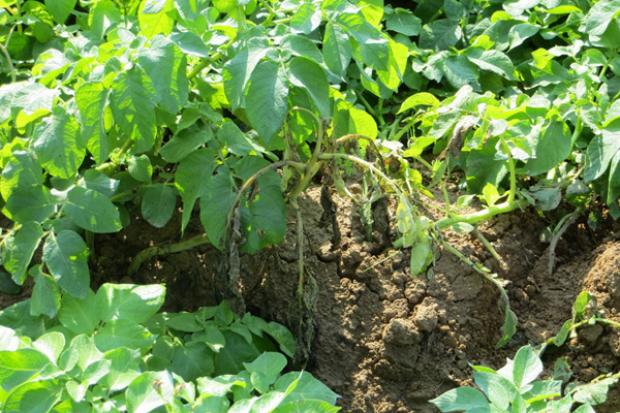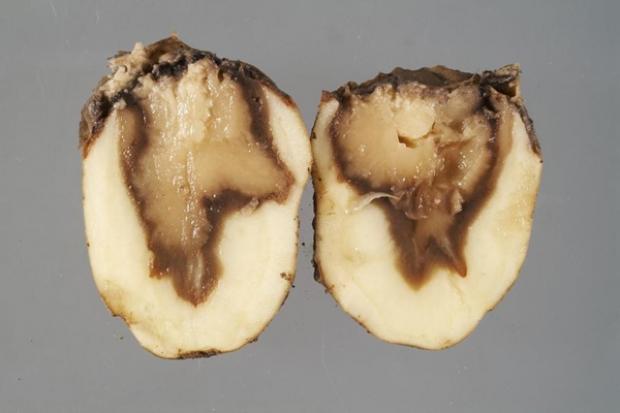Threat
It is evident from the experience of other European countries that Dickeya solani is more aggressive than other bacterial species that also cause potato blackleg in Northern Europe. Observations from other European countries indicate that, once established, Dickeya solani will rapidly displace other blackleg causing species and take over as the principal cause of wilting and blackleg-like symptoms in potato crops. Production losses in Dutch seed potatoes reached €25M in 2007 due to downgrading and rejection of over 20% of stocks during certification, almost entirely due to this new pathogen. Crop losses of up to 30% due to this pathogen have been recorded in Israel.
Northern Ireland Risk register rating
| Organisam | Hosts | NI Risk Rating |
|---|---|---|
| Dickeya solani | Solanum | 120 |
Susceptible species
Potato is the primary host for Dickeya solani but it also causes disease in hyacinth and has been found in association with the sedge (Cyperus rotundus), a common weed in Israel. The latter may serve as an alternative host in the absence of a host crop. All parts of the potato can be affected by Dickeya solani. Cultivar susceptibility studies have shown that all potato cultivars studied to date are, at least to some degree, susceptible. It is also clear that environmental factors, such as soil moisture, can have a dramatic effect on the severity of the disease in the field.
Spread
Dickeya solani is adapted to warmer temperatures but can cause disease under Northern Irish conditions. Since it appears to be more aggressive at higher temperatures there are implications for seed exports from Northern Ireland to warmer countries.
Outbreak stage and national plans
The pathogen has never been found in potatoes originating in Northern Ireland. Regular statutory testing of tubers in Northern Ireland and imported into Northern Ireland is helping prevent the pathogen from entering the country. Vigilance by workers in all stages of potato production industry in Northern Ireland is also helping keep Northern Ireland Dickeya solani free. Dickeya solani was first found in England and Wales in 2007 and in Scotland in 2009. There have been findings in Northern Ireland on crops grown from Dutch seed in 2010 and 2011.
Distribution
Dickeya solani has never been detected in crops grown with seed originating in Northern Ireland or Scotland. It has been detected in England (2007), Scotland (2009) and Wales (2007). The earliest known strains of Dickeya solani were originally isolated from hyacinth, leading many to speculate that the pathogen crossed into potato production from horticulture.
It has a widespread distribution across Europe, being found in Belguim, Czech Republic, Denmark, France, Germany, Netherlands, Poland and Spain to name but a few countries. Since 2004, Dickeya solani has spread over much of Europe and to Israel in less than 5 years through trade in latently infected seed potatoes. It was probably first introduced to Israel in 2004 via infected seed potatoes imported from the Netherlands. It was intercepted in Israel in exported seed potatoes from France in 2009 and from Germany. Dickeya solani has become the dominant cause of blackleg in Belgium since 2005 and is also the most important cause of blackleg in Switzerland.
Symptoms
Symptoms caused by Dickeya solani on the growing plant closely resemble blackleg in many cases. Wilting can be rapid with black soft rotting extending internally up the vascular system of the stem from the infected seed tuber.
Symptoms may vary depending on variety and in some, wilting can occur with no obvious sign of blackleg. High incidences of wilting (as much as 20%) have been observed in England as a result of planting Dickeya-infected seed in the warm early season conditions of 2007 and 2009.
Dickeya solani causes blackleg and top wilt of the growing potato plant and soft rot of tubers. The wilt may be rapid as the soft rot moves from the infected tuber through the vascular system of the plant. In some varieties, wilting may occur without any apparent blackleg.


Reporting suspect cases
If you think you have spotted the disease, please check our symptoms section before reporting it using one of the Further Information contact points below.
Management, grants, treatment
It is clear that Dickeya solani poses a significant threat to Northern Irish potatoes, both seed and ware. In Scotland, members of the potato industry have strongly supported measures to tackle this pathogen in order to maintain Scotland’s high plant health status. A zero tolerance for all Dickeya species is therefore in place under the Seed Potatoes Regulations (Northern Ireland) 2016. Strengthened plant health measures will also enable inspectors to take action to protect both seed and ware crops from Dickeya infection. DAERA inspectors will take stem samples from plants exhibiting blackleg symptoms during growing crop inspections, which will be sent to a competent laboratory (e.g. AFBI) to determine whether they are infected with Dickeya species. Crops found to be infected with Dickeya will not be allowed to be used as seed. They may only be sold as ware for immediate consumption or processing, and conditions will be imposed to prevent any contamination of other crops. All seed potatoes imported into Northern Ireland must be notified to DAERA and will be tested for Dickeya, as well as tubers selected for the annual survey for brown rot and ring rot. Continued vigilance from the Northern Irish potato industry is also required, in addition to these official measures, to maintain Northern Ireland’s high plant health status. The Northern Irish Government encourage all involved in the industry to comply with the statutory plant health controls and good practice set out below, to protect their own business and prevent this new pathogen arriving in Northern Ireland.
- Only source your seed and ware potatoes from a area that does not have a history of Dickeya solani in it’s production system.
- Notify DAERA of any imports of seed potatoes you bring into Northern Ireland, for planting, packing or retail (as required by the The Plant Health Order (Northern Ireland) 2006 as amended). Depending on risk, these will normally be sampled and tested for Dickeya species as well as brown rot and ring rot;
- Apply strict separation of seed and ware potatoes;
- Take care with the disposal of soil and waste, especially if you handle foreign ware;
- Be vigilant for symptoms in the crop and arrange a diagnostic test if you suspect Dickeya and contact your local DAERA inspector if you have a suspected or confirmed case.
The science
The taxonomy and organisation of the species we now know as members of the genus Dickeya has changed a lot in recent years. The species complex previously known as Erwinia chrysanthemi was split and renamed as several species within a new genus Dickeya – namely Dickeya chrysanthemi, Dickeya dadantii, Dickeya dianthicola, Dickeya paradisiaca and Dickeya zeae. With the exception of Dickeya dadantii subsp. dieffenbachiae all are known to cause disease in potato.
In 2005/2006 a growing number of cases of potato blackleg/top wilt in Northern Europe and Israel were found to be caused by a previously unrecognized Dickeya species, frequently referred to in early reports as Dickeya sp. biovar 3. Detailed study of this pathogen highlighted a close relationship to Dickeya dadantii, but ultimately it was considered sufficiently distinct to merit description as a new species - Dickeya solani. It can be readily distinguished from other members of the genus Dickeya on the basis of genetic sequence data.
Genome sequence data from a variety of different Dicekya solani isolates demonstrate clearly that Dickeya solani is a clonal organism; little variation exists between isolates from a wide variety of locations and environmental sources which adds weight to the view that this is a recently emerged pathogen. The analysis of the Dickeya solani genome has also indicated that it contains several unique genes to the genus Dickeya which may confer advantages for adaptation to new environments. Dickeya solani produces Gram-negative, motile, rod shaped cells. Dickeya solani is less susceptible to attack from soil saprophytic bacteria and is a highly efficient as a colonizer of the growing potato plant, when compared against another member of the genus Dickeya pathogenic to potato in Northern Europe. Dickeya solani does not survive well in soil in the absence of its host and earlier studies have suggested it may survive for as little as 7 days at 6°C and 50% field moisture capacity.
Origins
Scientists hypothesise that the Dickeya solani that infects potatoes may have evolved from a closely related strain that infects hyacinth. Infections in potatoes have only been recorded since early 2000’s, and this lends support to the hypothesis that it host jumped from hyacinth to potato. The origin of the pathogen is not known.
Pest risk analysis
There is no Pest Risk Analysis for this pathogen.
Import & movement restrictions
Legislation is in force to prevent the introduction and spread of Dickeya solani into and within Northern Ireland (Plant Health Order (Northern Ireland) 2006 as amended and The Seed Potatoes Regulations (Northern Ireland) 2016).
Risk from contaminated potato boxes
Boxes and crates for transporting potato tubers have been identified as a plant health risk by DAERA inspectors and AFBI scientists. Potato pathogens have a high likelihood of transmission if debris from infected stock is adhering to the inside of boxes. Potatoes infected with bacterial (e.g. such as Dickeya) and fungal (e.g. gangrene) diseases may leave plant material and/or soil in boxes which can infect other crops that are stored in the box. This is particularly a risk when boxes are used for imports, and then used for storage of seed.
Please see the leaflet ‘Dickeya Rot of Potatoes – the risk from contaminated potato boxes’ below for further information and risk control measures.
Further information
- Dickeya Rot of Potatoes – the risk from contaminated potato boxes
- DEFRA plant health risk register entry
- CABI datasheet
Questions and answers
Contact:
Plant Health Inspection Branch
DAERA Northern Ireland
Tel: 0300 200 7847
Email: planthealth@daera-ni.gov.uk
